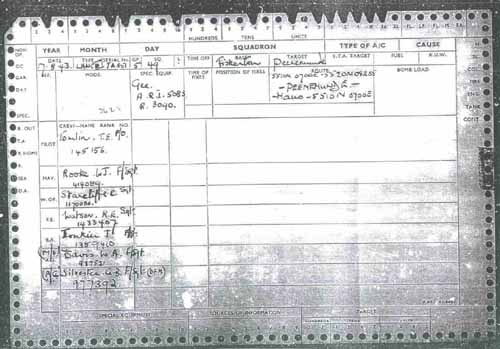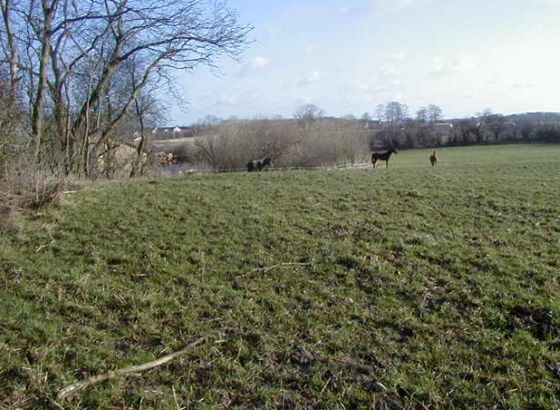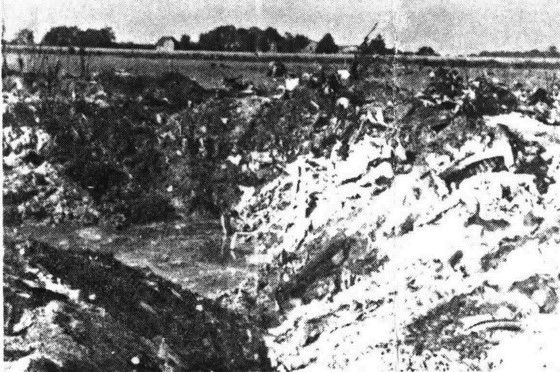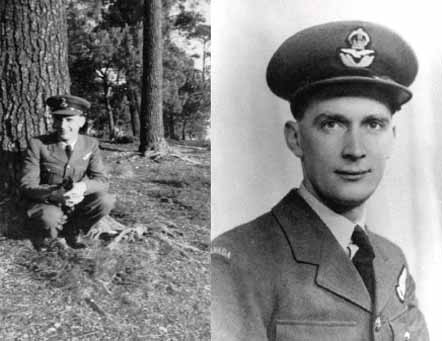The loss of JA851 and EE117
The first Lancaster to be shot down was that of P/O Tomlin, with an experienced crew on their 23rd operation. It is generally accepted that this Lancaster (JA851) crashed at Hellesøgård, a tiny settlement west of Nordborg.
Herr Krinner describes the action.
"It was a wonderful full-moon night. Suddenly I picked up a lot of contacts with my Lichienstein radar. There were at least five contacts, all clear ones. I guided the pilot to the first and, at about 200 metres, he told me he’d got it. He’d seen it. It was a Lancaster. He saw the eight flames of the exhaust. I looked back at this stage, for safety’s sake. I wanted to make sure that there was no Intruder behind us or even a German who might mistake us for a bomber.
Meissner closed up to within about fifty metres of the bomber — below and behind — opened fire and hit the right inner engine. It exploded after just one burst of fire, and large chunks of that engine broke off. We banked and watched it falling down in flames and saw it explode on the ground."

A composite panorama view taken from Hellesøgård looking between north and east.
A later description by Meissner states that the aircraft hit the ground "a few hundred yards from Ufer". Even on a highly detailed map I can find no such location and am led to believe that this is a misunderstanding over the German word "Ufer" meaning river bank. The bank in question being the Als Fjord.

Hans Meissner at (what is believed to be) the crash site of JA851.
Reports obtained locally say that the Lancaster (or parts of the aircraft) first hit the ground at Hellesøgård and then crashed at sea. Whatever the exact circumstances of the crash only the body of Pilot Officer Tomlin was 'officially' recovered; the other members of the crew being remembered at Runnymede.

The memorial to the crew of JA851.

The RAF loss card for this aircraft.
The third Lancaster shot down by Hans Meissner and Josef Krinner that night belonged to 619 Squadron from Woodhall Spa.

The aircraft, Lancaster EE117, was being flown by Wing Commander I J McGhie and crashed into these fields near the village of Ustrup.
Once again, Herr Krinner describes the action.
"Then we flew in a large circle and, while doing this, I picked up several more contacts flying towards us. The closing speeds were very fast. Meissner turned quickly and I picked up one of them from the rear and got right up to it — forty or fifty metres. Those great wings were spread out right across the front of us; we were too near really. After one burst of fire there was a huge explosion in the engine we had aimed at.
Parts flew past us on all sides. None of them hit us but our cockpit was covered with oil. I think it must have been oil and not petrol because we couldn’t see. That Lancaster went straight down, fast, not slowly like the other two."

The crashsite of EE117 showing the deep crater.

The aircraft had a crew of eight and their names are recorded on this memorial stone erected next to the crash site. From details recorded next to each name it can be seen that this was indeed a multinational crew with British, Australian and Canadian members.

The family of F/O Elmont Prest kindly provided these photographs. Elmont was a Canadian member of the crew and was a replacement that fateful night.